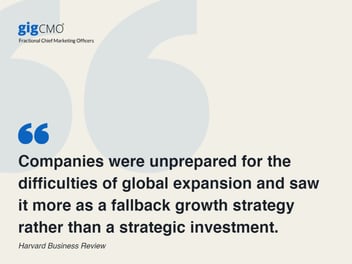
Choosing a location for market expansion isn't always straightforward. It's reasonable to assume that common factors such as geographical proximity or language make for apparent routes. However, detailed research to establish the actual size of the target market, the differences from domestic consumers and understanding the practical opportunities and challenges of different territories is fundamental to the success of market expansion.
At gigCMO, we seek to understand the challenges and opportunities that clients face. We have done extensive research into some of the most important factors to consider before choosing your new market when it comes to market expansion. Our research does the foundation work for you, providing benchmark information for more than 60 countries worldwide. It complements your own industry knowledge and insight based on a solid PESTEL (political, economic, social, technological, environmental and legal) and SWOT analysis (strengths, weaknesses, opportunities and threats) and understanding of key competitors. Combined with our research, you have a guide to help you prioritise your next market for success. This article explains some of the critical factors that we look at to help you choose your new market.
Population and population density
Looking at essential factors for market expansion is a filtering process. Start with the most significant elements and gradually filter out the information to understand the size of the opportunity and the challenges.
The population is an essential starting point as it acts as a general reference for the market size that your business can reach. Population density (the number of individuals per unit geographic area) serves as a baseline for understanding how your business should interact with potential customers.
Is it enough to have a high-street shop, or should you focus on a digital storefront with good logistics?
Top two cities and population percentage
The next thing that we look at is the top two cities in the country regarding population concentration. The largest cities often are the most attractive location for new businesses to launch. Depending on their proportion of the total population, they may even be the best location to remain focused on indefinitely.
Ease of doing business indicator
The ease of doing business indicator ranks economies from 1 to 190, with first-place being the best. A high ranking (a low numerical rank) means that the regulatory environment is conducive to business operation. The business index averages the country's percentile rankings in ten topics covered in the World Bank's Doing Business. It is an excellent way to gauge how easy it will be to set up and operate your business in your target market.
GDP per capita
A country's total GDP and GDP per capita provide a quick insight into how wealthy the average person is and can help you calibrate expectations and price points for your service. For example, GDP per capita is particularly interesting if you're considering market expansion to India, where there is an enormous population but very few people with large amounts of money. Therefore, if you have a luxury product, what seems like an excellent opportunity at the start could quickly dwindle to a tiny market. That might not mean it is not a viable option, but it may require companies to reconsider their marketing strategy and pricing models.
Industry specialism
Looking at the most significant export industry that a country has helps you understand its defining sector on an international stage and enables you to begin generating ideas on how to integrate. Meanwhile, ascertaining the industry specialism of the top two cities helps you determine who is generating dynamism within the most productive city in the country. This enables you to focus on who and what is vital to this city and where your business fits.
Age dependency ratio
The age dependency ratio is information that helps you understand the market a bit better. It looks at the number of people under 15 and over 65 (working age). It provides an insight into whether the population is ageing or not and what the future could hold for the country and business opportunities.
Top Hofstede traits
Hofstede traits look at how a country prioritises collective cultural characteristics as defined in categories researched by Dr Gerard Hendrik Hofstede, a Dutch social psychologist well known for his pioneering research on cross-cultural groups and organisations.
Looking at what these traits are and the strength of those traits provides insight into a region's cultural and societal nuances. It informs how to interact and target the market while being respectful of the country's culture. For example, we have previously spoken about the importance of cultural values when marketing to the different nations within the GCC.
OECD E-Government ranking
The OECD E-Government ranking uses information and communications technologies (ICTs) and the Internet to achieve better government. Essentially, how easy it is to use technology to access government services and, by proxy, the digital engagement of the country?
The ranking helps you understand how easy it is to do business - the ease of accessing information, communications and transacting business.
While the information that we provide companies with at the outset is not personal to them, it can help you begin to understand where opportunities are rather than going with what seems obvious. It enables a more strategic approach to the next phase of discovery, which should be done well to minimise long-term risk, but requires investment into meaningful market research. Our knowledge enables you to get a head start on that process.
Would you like to discuss overseas opportunities for you and your business and create an insightful, strategic approach to market expansion? You can speak to our team or attend one of our upcoming Go To Market meetings. Contact us for more information.



